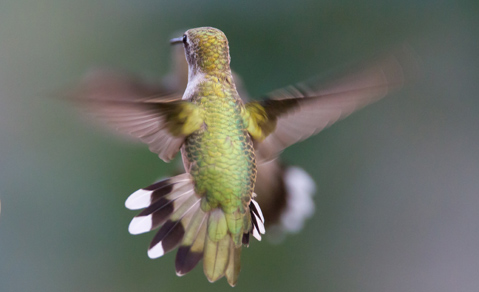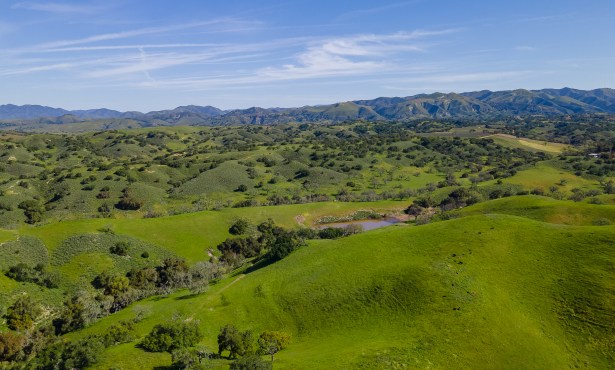Backyard Wildlife: At Home with Hummingbirds
How to Make Hummingbirds Happy Along the Santa Barbara Coast

When I first arrived in California, hummingbirds were new to me. Having grown up in Europe, these New World gems held special fascination for me, and still do.
Along the Santa Barbara coast, we’re lucky to have the Anna’s hummingbird (Calypte anna) in residence all year. The species is fairly common and the main visitor to most hummingbird feeders, not to mention perches and sprinklers. Adult males often have bright red or magenta throats (gorgets) and crowns that flash in the sun, while females have more modest coloring with red central throat patches. The juveniles look more like the females.
Several other hummingbird species can be seen in the summer or passing through as they migrate. Common Birds of Santa Barbara, written by Edward S. Spaulding in 1928, lists Anna’s as well as the Allen’s, Black-chinned, Calliope, Costa’s, and Rufous hummingbirds.
Do you know what hummingbirds feed on? Well, nectar from flowers is an obvious first answer. Hummingbirds have long tongues with special grooves running the length of the tongue that allow them to feed efficiently on nectar produced at the bases of flowers. They also feed on small spiders and insects, which you can spot if you watch carefully.
Some species also love tree sap, which I recently learned in our orchard. The previous year, a red-breasted sapsucker drilled wells into an apple tree, and then returned to work on the same tree this past winter. These woodpeckers are shy, and although many trees are pitted with their characteristic rows of wells, it is rare to actually see the birds that make them. They nest in higher-elevation forests, but descend the slopes to our area in the cooler months. As I watched the sapsucker drill fresh wells, tree sap overflowed in dribbles down the bark of the tree. Wasps soon flew in to feed on the sweet liquid, followed by a warbler and then a hummingbird.
My observations were backed up by the literature, which described hummingbirds that would even follow sapsuckers around. In fact, some hummingbirds depend quite heavily on sap during their long migratory journeys. Tree sap is similar to nectar, being a mixture of sucrose, water, and amino acids.
To attract hummingbirds, many people put out feeders. You can make your own solution at home by dissolving one cup of sugar in four cups of water, which, incidentally, does not need to be colored red. To keep feeders clean, boil the solution to delay growth of microorganisms that may harm hummingbirds, and replace the sugar solution frequently. The website of Audubon California at the Kern River Preserve (kern.audubon.org/hummer_feeding.htm) is a great feeder resource.
A more natural approach is to create a native plant garden. Hummingbirds are important pollinators of many California natives that have red or pink tubular flowers, but they also pollinate flowers of other colors. It’s best to select plants that flower in succession through the seasons. Fuchsia-flowered gooseberry (Ribes speciosum) and other native gooseberries and currants bloom in winter and early spring. Hummingbird sage (Salvia spathacea) blooms in spring. Climbing or honeysuckle penstemon (Keckiella cordifolia), scarlet larkspur (Delphinium cardinale), scarlet bugler penstemon (Penstemon centranthifolius), and sticky monkeyflower (Mimulus aurantiacus) bloom in late spring and early summer. California fuchsia (Epilobium canum) blooms in summer and fall. And if you have a pond or wet area in your garden, you can plant the moisture-loving scarlet monkeyflower (Mimulus cardinalis) along the edge. See sbnatives.com or visit the nursery at the Santa Barbara Botanic Garden to find these plants.
Hummingbirds take a great deal of care in making their tiny and exquisite cup-shaped nests. They use spiderwebs, lichens, and other specially chosen materials. Some hummingbird lovers hang supplies of purchased nesting materials like cotton fibers in suet cages in their gardens.
Hummingbirds also line their nests with soft materials such as the hairs from the fuzzy leaves and fruits of our native Western sycamore (Platanus racemosa). But if you plant a sycamore, make sure you buy the native one, not a London planetree, which looks quite similar. These cultivated hybrids, often sold by nurseries, cross easily with our native sycamores, thus leading to genetic contamination in natural areas.
To learn more, refer to The Sibley Field Guide to Birds of Western North America by David Allen Sibley, and for even more detail, see the National Audubon Society’s The Sibley Guide to Bird Life & Behavior or National Geographic’s Complete Birds of North America, edited by Jonathan Alderfer.



